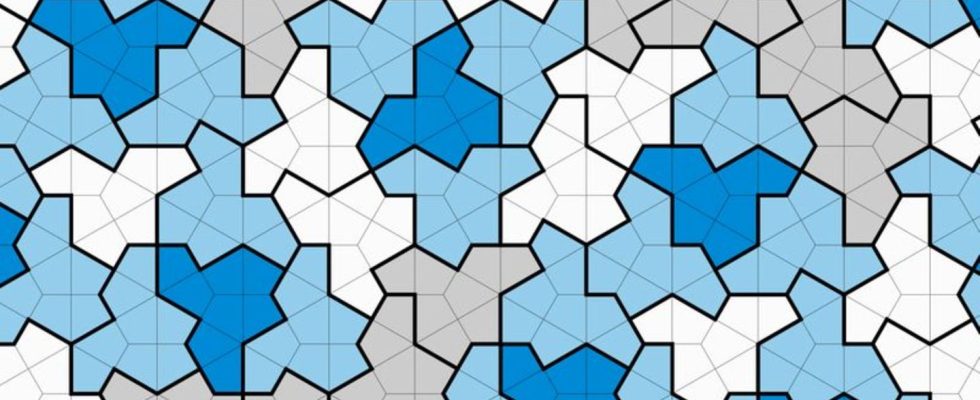mathematics
The hat has 13 corners – and solves a puzzle
The illustration shows a field of tiles that have 13 corners and resemble a hat. photo
© Craig S. Kaplan /dpa
Mathematicians have solved this problem: How can you tile an infinite surface without gaps without a basic scheme repeating itself regularly? The answer has 13 vertices and a few edges.
If you don’t feel like regularly recurring patterns when laying tiles, you have a team of professional and amateur mathematicians to thank for a new option.
The men from Great Britain, Canada and the USA have found a tile form with which an infinite surface could be laid out without gaps, without a basic pattern being regularly repeated. Experts call this aperiodic tiling. The tile has 13 corners and, with a little imagination, resembles a hat.
The search for such a form is based on a purely mathematical question, a puzzle – if you will. It has no real relevance for practice. “Aperiodic tilings are rarely used,” says mathematician Dirk Frettlöh, who is studying the subject at Bielefeld University.
Family of aperiodic tile patterns
The whole thing goes back to Roger Penrose and Robert Ammann, who introduced a family of aperiodic tile patterns around 50 years ago – including the “Penrose tiling”. However, different tile shapes were combined in each case, for example two rhombuses with different interior angles. There was the question of whether such a tiling is also possible with just a single tile shape. Such is called “Einstein” (“aperiodic monotile”).
All previous solutions were not entirely satisfactory, explained Frettlöh. Sometimes it went into three-dimensional space, sometimes tiles overlapped in some places, sometimes there were additional restrictions or rules that seemed artificial.
However, the “hat” tile by David Smith, Joseph Samuel Myers, Craig S. Kaplan and Chaim Goodman-Strauss is not undisputed among experts. Because with it you can only seamlessly tile a surface aperiodically if you mirror it in several places. The scientists refer to their discovery as “Einstein”. Critics, however, complain that the tiles do not cover an area without gaps just by rotating the original shape.
Above all, Frettlöh is critical of the fact that one of the two variants – original form or reflection – always has to be in the majority. Therefore, all surfaces parquetted with it can be divided into two groups: one with more original tiles, the other with more mirrored ones. With a perfect solution there is no difference, then all conceivable cases are homogeneous.
“You have to look closely”
In addition, Smith and Co. did not provide any really deep or interesting mathematical proof for their solution, Frettlöh continued. “Even a layman with no mathematical knowledge can figure it out with a lot of puzzles.” The true art of his discipline does not come into its own, said the mathematician. Still, he concedes to the researchers: “Right now, it’s the best example we have.”
Paradoxically, the irregularity is not necessarily noticeable when looking at it. “You have to look closely to see the coincidence,” said Tim Rohe, Professor of Perceptual Psychology at the University of Erlangen-Nuremberg. According to him, the fact that the shape of the tile in the depictions is always basically the same helps to give the impression that everything looks very regular.
This is because the human brain is always trying to recognize structures – even where there are none. As an example, Rohe mentioned that one sometimes thinks one can recognize animals in clouds or faces in slices of bread. “The brain doesn’t work like a camera,” he explained. It receives more or less “noisy signals” and tries to make a model out of them.
The perceptual system develops after birth, so pattern recognition is only acquired. For example, there are more vertical and horizontal lines in the environment – which is why people can usually perceive them better than oblique ones.

